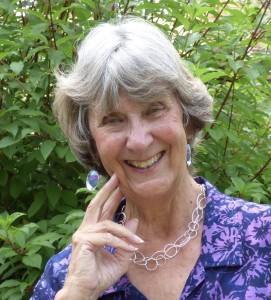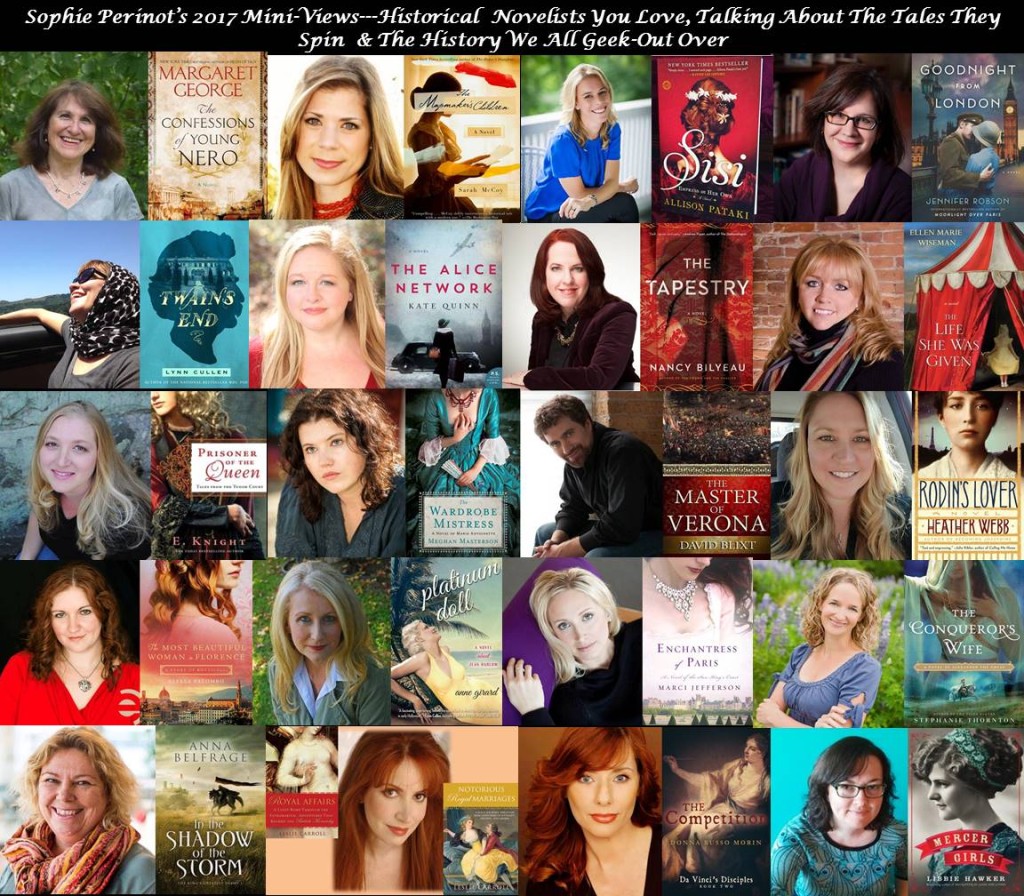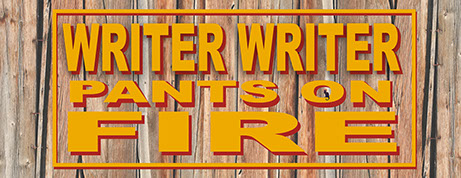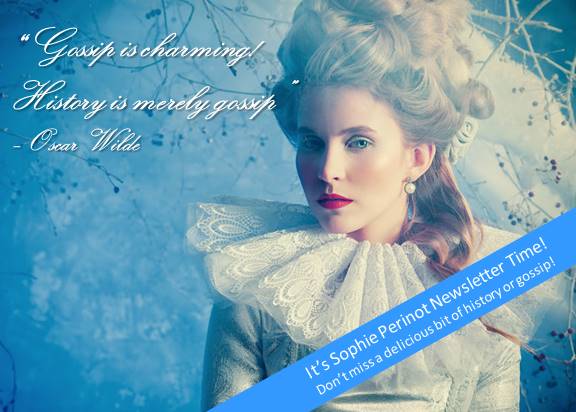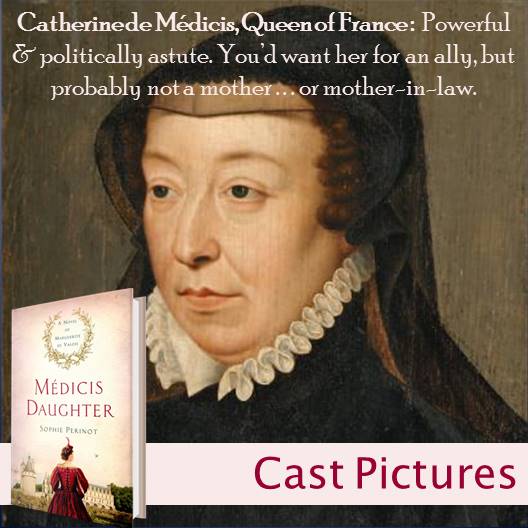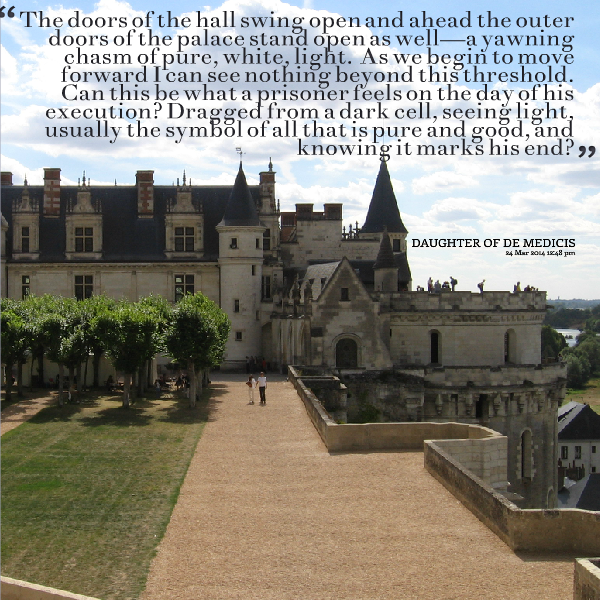Category: Author “Inner-Views”
Co-Writing Historical Fiction & The Dramatic Destruction of Pompeii
Had a marvelous discussion with fellow historical novelist Ryan Byrnes about the recent re-release of A DAY OF FIRE, the first continuity novel in the historical fiction genre. Take a watch and learn about the tricky and exciting process of 6 authors co-writing a novel together, as well as what I personally think tales set in the past allow modern readers to do.
Interview with Laura Morelli, Author of THE GIANT
If you’ve been to Florence you’ve seen Michelangelo’s David. If you haven’t been to Florence you’ve seen countless images of him. The David is a cultural icon and even 500 years after his creation still has the power to leave us awe struck.
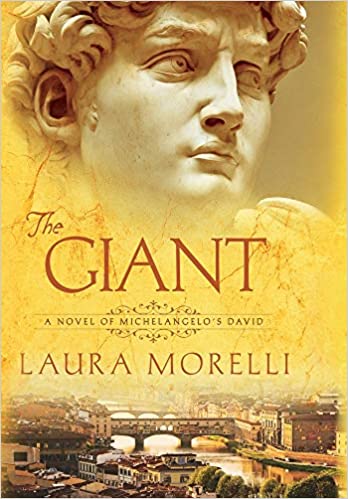
Now Laura Morelli—talented novelist and PhD Art Historian—has a breathtaking new novel out about the creation of this Renassaisance Art Masterwork, and I am THRILLED to welcome her to my blog today to talk about the process of creation for both her novel, THE GIANT, and Michelangelo’s David!
Let’s start things off with a teaser for THE GIANT . . . .
As a colossal statue takes shape in Renaissance Florence, the lives of a master sculptor and a struggling painter become stunningly intertwined.
Florence, 1500. Fresco painter Jacopo Torni longs to make his mark in the world. But while his peers enjoy prestigious commissions, his meager painting jobs are all earmarked to pay down gambling debts.
When Jacopo hears of a competition to create Florence’s greatest sculpture, he pins all his hopes on a collaboration with his boyhood companion, Michelangelo Buonarroti. But will the frustrated artist ever emerge from the shadow of his singularly gifted friend?
From the author of THE PAINTER’S APPRENTICE and THE GONDOLA MAKER comes a gorgeously crafted, immersive tale of Renaissance Italy.
Laura, I have such distinct memories of the first time I stood in front of Michelangelo’s David—gape-mouthed and totally in awe. What do you think draws people to the David?
Me too! I am always amazed at the number of people who tell me that this sculpture is the thing that impressed them the most on a trip to Italy.
In fact, when my family returned from Italy last summer, I asked my four teenagers to name the top three favorite things they saw. The David was on the top of each of their lists (and I promise I tried not to influence their choices!). I think that’s amazing.
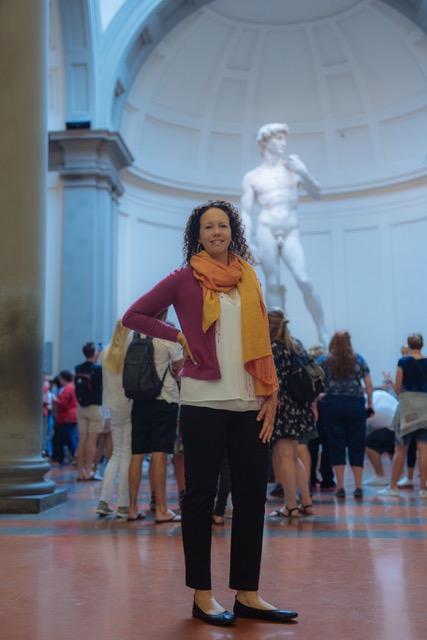
A Time Magazine article in the 1980s reported on the “emotional trauma” experienced by first-time viewers of the David. And a few visitors have even tried to disrobe before the statue, only to be quickly led away by museum guards!
I have long wondered what it was about this statue and the irreverent stone carver who made it that still has the power to capture people’s imagination–to make their jaws drop, to leave them speechless–even in our current time of multimedia overload. And even after studying it for some thirty years, I’m still not convinced it’s something that can be put 100% into words. That’s the power of art!
As a PhD art historian, how do you think the David influenced the course and direction of art at the moment of its unveiling and in the aftermath of its creation?
The David was the first colossal nude on Italian soil since ancient Roman times. Think about that… For a thousand years, no one had seen a nude male sculpture of this scale. But this David is actually a biblical hero in the guise of an ancient god, at the same time that he appears as a god in the image of a perfect man. He is both an Adam and a Hercules, both a Christian and a civic / political symbol. In short, the David seems to telescope all the aspirations and the ideals of the High Renaissance in a single work of art. I don’t think any sculptor who worked in Europe after 1504 could ignore it. Later works, like those of Gianlorenzo Bernini, would have been unimaginable without Michelangelo’s precedent.
Sometimes truth really is stranger than fiction. Can you share a fact or scene from The Giant which actually happened (or existed), but seems too strange to be true?
We have an amazing contemporary account of the sculpture leaving the cathedral workyard, where Michelangelo had been working on it for four years. At midnight on May 4, 1504, laborers broke the stone lintel above the gate of the workyard and began to move the sculpture slowly toward the Piazza della Signoria. They suspended the sculpture from a contraption made of ropes and pulleys, as well as greased logs to roll it forward. It took several days to reach its intended location. During that time, some boys were arrested for throwing stones at it; one of them turned out to be a relative of Lisa Gherardini—yes, the Mona Lisa (whose portrait Leonardo da Vinci was painting at the time, just a few streets away). You can’t make this stuff up!
Of course Michelangelo is not the only artist in The Giant . . . can you tell us a little bit about Jacopo Torni (or the artist he is based upon) and why you felt his story needed to be told?
As I looked for the right person to tell the story of Michelangelo’s gigante, I came across historical references to a Florentine fresco painter called Jacopo Torni, also known as L’Indaco.
The sixteenth-century art historian Giorgio Vasari tells us that L’Indaco lived “in close intimacy” with Michelangelo, and that Michelangelo found L’Indaco the funniest and most entertaining of his friends. We also know that Michelangelo invited L’Indaco to work with him on the Sistine Chapel in 1508. According to some sources, it was a friend who convinced Michelangelo to return to Florence to take on the David commission in 1501, and I like to think it was L’Indaco.
Michelangelo is one of the most notoriously temperamental artists in history, and I wondered about this relationship of seeming opposites. It is this push and pull of two creative friends, in combination with the creation of two of the most seminal works of art history—the David and the Sistine Chapel ceiling—that drew me to this story and made me want to explore this complicated friendship further.
Finally, I’d like to close out things with a Rapid Fire round:
- Favorite Italian dish: Risotto alla milanese, without a doubt!
- Character you’d love to write about but probably never will: A living artist.
- Why won’t you? It would be so tricky, I think, to write fiction or nonfiction about a real person who is either living or recently deceased.
- A piece of art that is special to you other than the David: I saw the cathedral of Notre Dame in Paris when I was 12 years old, and it was a “coup de foudre.” It led me to want to pursue art history and it’s still such a special building to me.
- Do you write to music or in silence? I love peace and quiet when I write.

Thanks so much to Laura for stopping by! Don’t forget to pick up your copy of THE GIANT readers—at Amazon, Indiebound, on Bookshop.org to support Independent booksellers, or your favorite local bookstore!
INTERVIEW: Anne Easter Smith Dishes on Her Upcoming Novel About Richard III
Today, while on a short break from the mega-tour for my own latest novel Ribbons of Scarlet, it is my very great pleasure to host my good friend the insanely talented, multi-published, Anne Easter Smith in a Q&A to talk about her upcoming novel: This Son of York (releasing November 10th but you can pre-order now HERE).
This Son of York concludes Anne’s best-selling Wars of the Roses series. She’s made the much maligned Richard III, who was brought into new focus following the discovery of his bones under a car park in Leicester in 2013, her protagonist and is determined to give us a very different view of Richard than Shakespeare and stereotypes have . . .
Anne, people have very strong opinions about Richard III despite the short time he was on the English throne. Writing about Richard is, in many ways, like walking out into a battlefield mid-conflict, so let me start right off by asking why a novel centering on Richard? What compelled you into this contentious territory?
I love a good battle! Especially one with horses, armored knights, and longbows. But as far as Richard is concerned, he became a cause for me once I took in the Josephine Tey theory that those adorable princes in the Tower weren’t murdered by their hunchbacked uncle Richard but may have lived into the next reign. Horrible Henry Tudor (no, not that one with all the wives but his father) had far more to lose than Richard if indeed those little boys were still alive, because he had no right to the throne. But I digress.
Tey’s book Daughter of Time got me researching everything I could about Richard and the Wars of the Roses, and after five decades I feel quite knowledgeable enough to have written my version of Richard’s story. You may be surprised to know that faux news began a lot earlier than today! Shakespeare’s sources for his play were Tudor historians who spun the historical facts about Richard so well that we still believe them today (even though much new evidence has come out in the meantime, if not exonerating Richard of those many crimes laid at his door, at least raising plausible doubt.) Being a Brit, fair play is in my DNA, and Richard has been unjustly depicted through the centuries.
What is the pernicious misconception about Richard that you’d most like to correct in the minds of readers?
That he murdered his nephews in the Tower in order to “steal” the crown. No bodies have ever been found, no evidence they were even murdered, and no witnesses or confessions to the deaths have surfaced in all this time. From everything I have studied about Richard, he was never interested in wearing the crown. It was pushed on him by Parliament when the princes were revealed to have been illegitimate (their dad, Edward IV and Richard’s brother, had been secretly “contracted” to a woman prior to marrying their mum.)
Is there such a thing as a fun-fact when it comes to Richard III—and if so can you share one?
Hmmm, I don’t have him picking his teeth with his knife (that was a no-no even for the most ill-bred), but “fun” and Richard is a bit of an oxymoron. He was a naughty boy before he married Anne Neville (at 19), because we know he had two and possibly three bastards. He was very discreet about their mother(s), but two of them were brought up in his household and mentioned in letters and household accounts.
I know This Son of York has taken considerable time, research and thought on your part, can you offer us a little window into your process of creating the book?
After Royal Mistress was published in 2013—the fifth book in my series about the Yorks during the Wars of the Roses—I thought I was done with Richard and his family, and I started to write a wonderful story about a Portuguese prince and his mistress in 14th century. (It took me several years of research and three trips to Portugal to feel comfortable writing about this prince.) And then they found Richard’s grave under a car park in Leicester in 2012 and I was so excited and intrigued by the new information the bone analysis gave us of him that I dropped poor Pedro into the Tagus River and took up Richard’s cause again. After all, I had every date and event and character I needed to write about still stuck in my brain, but with new info on Richard—like severe scoliosis and that he drank heavily in the last two years of his life—I was moved to return to Richard and write his story for a new century.
My process is mostly being as organized as possible. I have charts of timelines where I make sure no real person is in the wrong place at the wrong time, unless it’s unclear and then I can fictionalize meetings or scenes. But I don’t mess with history.
Thank you so much for taking the time to stop by the blog and begin to set the record straight on Richard, Anne!
Thank you so much for hosting me here, Sophie. I am so passionate about readers knowing more about Richard than Shakespeare’s “bunch-backed toad” and I think I am giving them a more balanced view of this much-maligned king. He only lived to be thirty-two, and only reigned for two years, but his whole life was devoted to being loyal to his family, his king, his wife, and if I get just one person to change their opinion of him by doing the research I did, I will be satisfied! I promise you, his is quite the dramatic story!
Finally for those who want to purchase This Son of York—and after reading Anne’s answers I am betting that is everyone—remember if is available for pre-order on Amazon! Below I’ve included a description of the novel, and some of the praise it is already garnering!
Praise for This Son of York . . .
Anne Easter Smith has written five well-regarded novels set in the War of the Roses, but the one she has been preparing to write, both in her imagination and after fifty years of research, is this novel about Richard III. Her mission was to bring Richard Plantagenet the man to life and let him speak directly to us in this meticulously rendered novel.
—Margaret George, International best-selling author of Elizabeth I and The Confessions of Young Nero
Deeply researched, the book bursts with action but even more importantly we are given passages of real feeling between human beings we think we may know but perhaps never completely understood until this book. It is a moving, insightful, and engrossing depiction of the controversial king.”
—Nancy Bilyeau, best-selling author of The Blue
A wonderfully realized life of tragic, doomed Richard. The author uses the latest discoveries and old texts to fully explore the complicated ‘crouchback’, and give us a fine portrait of the lover and the warrior, a noble, flawed and heroic king and man.”
—C. C. Humphreys, author of Vlad: The Last Confession
THIS SON OF YORK
Concluding her best-selling Wars of the Roses series, Anne Easter Smith has made Richard III her protagonist in her latest book This Son of York. The much maligned Richard is brought into new focus following the discovery of his bones under a car park in Leicester. 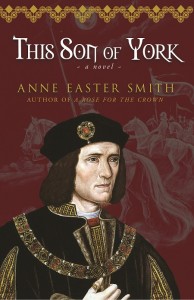
As the fourth son of the duke of York, Richard of Gloucester could not have hoped for much more than the life of a wealthy, but insignificant nobleman. Instead fate took him down a drama-filled, unexpected path to the throne. As York challenged Lancaster for the crown, early tragedies and betrayals, including by his faithless brother George, led the young Richard to count on none but himself. Imbued with the traits of loyalty and duty to family and country, he proved them time and again especially when he reluctantly came to wear the crown. Buoyed by the love of two women, he stayed true to one while cherishing the other, both helping him bear the burden of his scoliosis.
A warrior of renown, a loyal brother, loving husband and father, a king mindful of injustice yet beset by betrayal, and a man convinced his God has forsaken him by burdening him with crippling scoliosis, This Son of York has a compelling tale to tell. With her meticulous attention to detail—and the truth—Easter Smith’s compelling storytelling paints a very different picture of the king Shakespeare reviled as “…thou elvish-marked, abortive, rooting hog.”
It’s Women’s History Month and I Sit Down With Greer Macallister to Talk About Intersections Between the Past and Women’s Presents
Greer Macallister, bestselling author of THE MAGICIAN’S LIE and GIRL IN DISGUISE. is doing a wonderful series of #womenshistoryreads interviews in honor of WOMEN’S HISTORY MONTH. So far she has featured some of my favorite authors like Kate Quinn, Allison Pataki, Sarah McCoy and Heather Webb.
TODAY IT IS MY TURN! Check out our wide-ranging discussion touching on everything from historical graffiti, the bond between sisters (even when they are queens) and how historical women would identify with the stories of today’s #metoo movement.
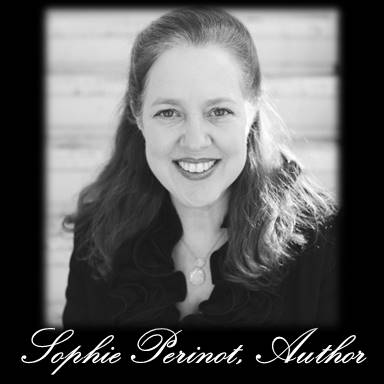
Exciting Mini-View Lineup For 2017!!!
Wondering if you should bother to open my AUTHOR NEWSLETTER when it pops up in your mailbox? Or whether you should SUBSCRIBE?
Look at this Mini-View lineup! In just in the first three issues of my author 2017 newsletter readers will hear from:
NYT bestsellers: Allison Pataki and Sarah McCoy; USA Today bestseller Jennifer Robson, as well as authors Anna Belfrage; Leslie Carroll; Eliza Knight; Meghan Masterson; Stephanie Thornton; and Ellen Marie Wiseman.
And that’s just for starters. HEAR SOME OF THE TOP TALENT IN HISTORICAL FICTION talk about topics like: dangerous historical women, writing about society’s outsiders, surprising things historical women did, the men who populate history and how they would cast their book as a TV mini-series!
My First Podcast: Have A Listen!
How long have I known Mindy McInnis, Edgar Award-winning author of YA fiction? Too long for me to fess up. But let’s just say we knew each other before we were agented let alone published!
Mindy runs an awesome blog for aspiring writers called Writer, Writer Pants on Fire, and a pod-cast of the same name which features interviews established authors taking about the nitty-gritty of the road to publication. TODAY I AM HONORED TO BE HER FIRST “ADULT” AUTHOR ON THE PODCAST (though I am not sure the label adult is entirely apt for me 100% of the time).
Interested in how I landed my agent, what my submission process was really like, why I tend to hop around from era to era when writing? Have a listen!!!
Extra, Extra, Read All About It!
Did you know Dear Readers that I have an awesome newsletter? My 2017 newsletter is ALL about feeding readers’ cravings for more delicious gossip—I mean HISTORY (see the Oscar Wilde quote below)! It will come out monthly, and each month will have its own theme. One FANTASTIC new feature–the Mini-view–will appear in every issue. Each Mini-view asks 3 top historical novelists a single question and brings you their answers.
The latest issue is just out! It’s all about DANGEROUS WOMEN (Catherine de Médicis anyone?). So if you are already a subscriber check your inbox. And if you aren’t . . . never fear, it is not too late! Click here and fill out the form! The newsletter will be in your box in a jiffy.
Oh For the Hook of a Book Has Me In The Hotseat
Want to know what I really think about Catherine de Médicis? Let me tell you folks when Erin Sweet-Al Mehairi at “Oh for the Hook of a Book” puts you in the hot-seat you spill your guts: everything from to which characters you enjoyed writing most and least to your guilty TV pleasures . . . It doesn’t hurt that Erin is excellent company and offers virtual cheesecake as an inducement 😉 Explore the creation of MÉDICIS DAUGHTER through Erin’s in-depth interview.
I am in the Hot Seat
As part of the celebration marking the release of “A Day of Fire: A Novel of Pompeii” blogger Erin Sweet-Al Mehairi is running a 6 part interview series asking each of the authors who contributed to the novel the same two questions. Today is my day in the hot seat. Stop over at Oh for the Hook of a Book and find out what I believe I brought to the table (or the volcano gods as it were) in working on this ground-breaking collaborative novel.
My Writing Process
My good friend and “goddess of historical fiction” Kate Quinn tagged me in this cyclical blog tour (make sure you pop over to Kate’s blog and see her answers then follow the chain back for insight into the minds and work habits of other historical fiction luminaries like Christy English and Stephanie Dray). Four questions designed to reveal how we do what we do—write books that is. Answering is harder than you think (as is writing books) because most of us write as we breath—because we are compelled to. And, unless called to account by questions such as these, we don’t think a lot about it.
1) What am I working on?
I am putting the finishing touches on “Daughter of de Médicis: A Novel of Marguerite de Valois” before handing it over to my agent for his input. I consider the book a true bildungsroman, focusing on the psychological and moral growth of the enigmatic Marguerite de Valois from the point at which she comes to live with her brother Charles IX’s royal court as a young girl to the moment when she is transformed by a tremendous historical event (the Saint Barthlomew’s Day massacre in Paris) into an independent adult. I’ve always been fascinated by Marguerite—daughter of a King, sister of three and wife of Henri IV. Had she lived in England Marguerite would have ruled in her turn, but Salic law in France relegated her to the sidelines. Her relationship with her powerful mother, Catherine de Medicis, is an important aspect of the novel. Let’s face it, the mother-daughter relationship is always fraught with peril during the teen years, but imagine if your mother was Catherine de Medicis!
If you are interested in learning more about “Daughter of de Medicis” (including more cool sneak-peek quotes like the one below), it has its own Facebook page.
2) How does my work differ from others of its genre?
Every author’s voice is different. I have mine. You either like it or, perhaps, you do not. But it is different from anyone else’s. Beyond that I cannot opine because I make a conscious effort NOT to compare my work to the work of other historical novelists. In writing as in life I find such behavior is not particularly productive. More than that, it can lead to some pretty negative stuff/feelings. I write for the joy of it. I don’t view it as a competitive sport and I fear indulging in comparisons can too often lead to that.
3) Why do I write what I do?
I write historical fiction because I love to read it. Also because I am a bona fide history geek (have my BA in history) from a family of history geeks (my only sister is actually a Professor of History). When I was a child, I visited historical sites while other kids were at amusement parks. I also grew up watching all those Masterpiece Theater costume dramas of classic literature, and ninety-nine percent of my favorite books were (are) set in the past. So, historical fiction was a natural niche for me. Since I studied French abroad, and I am a devotee of Alexandre Dumas, peré, both my first novel (“The Sister Queens”) and “Daughter of de Medicis” have French history at their centers.
4) How does your writing process work?
“School is my friend.” I bet every parent out there who works at home can identify with that. When my writing is going well, the hours between dropping off and picking up my son from school are devoted 100% to writing. This can have some unfortunate side-effects—usually in the form of the plaintive cries of family members claiming they are, in fact, wearing their last pair of clean underwear. To balance my various roles and not feel like a hamster on a wheel, I try to be fully present and in each given moment. I try not to think “oh my god, you should be writing” when I am not. That kind of thinking tends to just create a guilt-induced writer’s block when I finally sit down at the keyboard. Oh and I don’t compare my daily word count to others—ever. I am a “slow first draft” writer, but the first drafts I eventually produce tend to be close to ready to handover to my critique partners, agent or editor. Finally my process involves weekly summits with a pair of fellow novelist whose work I adore and opinions I respect. We work through problems and set goals—basically we keep each other on-track and honest in a profession that can, by virtue of its solitude, allow for a good deal of procrastination.
Well that’s all she wrote—or rather how she writes (with the “she” being “me). My friend Nancy Bilyeau is up next. On Monday, April 7th she will offer insight into her own creative process, a process that’s led to her gripping Sister Joanna Stafford series (“The Crown” and “The Chalice” with a third installment on the way). Check back here next Monday March 31st, and I’ll link to her site so you can see what her answers are.
